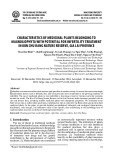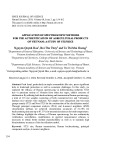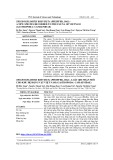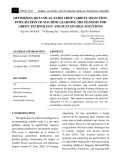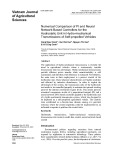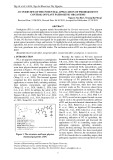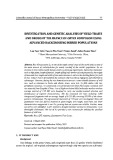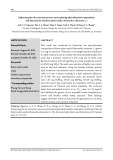
Int.J.Curr.Microbiol.App.Sci (2018) 7(7): 232-240
232
Original Research Article https://doi.org/10.20546/ijcmas.2018.707.028
Long-Term Manuring and Fertilization Effects on Soil Physical Properties
after Forty Two Cycles under Rice-Wheat System in North Indian Mollisols
Pawan Kumar Pant* and Shri Ram
Department of Soil Science, College of Agriculture, G.B. Pant University of Agriculture &
Technology, Pantnagar, U.S. Nagar, Uttarakhand, 263145, India
*Corresponding author
A B S T R A C T
Introduction
Rice–wheat cropping system is the world’s
largest most prominent cropping system
occupying around 12.3 M ha in India around
85 percent of this area falls in Indo-Gangetic
plains (Ladha et al., 2003). The Indo-Gangetic
plains region of India has Rice–wheat
cropping sequence spread over a vast area
from Punjab in the Northwest to East up to
West Bengal (Singh et al., 2005). The
deterioration of soil physical heath due to
continuous cultivation without acceptable
replenishment poses an immediate threat to
soil health and environmental securities.
Continuous cultivation of crops and excessive
use of fertilizers is depleting the soil physical
health hence, there is a need to reintroduce the
International Journal of Current Microbiology and Applied Sciences
ISSN: 2319-7706 Volume 7 Number 07 (2018)
Journal homepage: http://www.ijcmas.com
An investigation was carried out at Norman E. Borlaug Crop Research Centre of G. B.
Pant Univ. Agric. & Tech. Pantnagar, U. S. Nagar, Uttarakhand, India in order to study the
influence of long-term applications of fertilizers and manures on different soil physical
properties after forty two cycles in silty clay loam textured Typic Haplustept under rice-
wheat cropping sequence during 2012-13. The field was laid out in a randomized block
design comprising of ten treatments. Various soil physical properties were measured in
surface and sub-surface soil after harvest of rice and wheat crops after 42 cycles and it was
found that in 0-60 cm soil layers, the bulk density was significantly lower in 100% NPK +
FYM over other treatments. The balanced application of NPK decreased the bulk density
in all the soil depths. Irrespective of soil depths, the control plot invariably showed higher
bulk density. The soil receiving 100% NPK fertilizers with FYM recorded significantly
higher hydraulic conductivity, water holding capacity and mean weight diameter in soils of
all four depths, respectively as compared to control and all other fertilizer treatments.
Application of P in combination with N significantly increased the hydraulic conductivity
in comparison to where N was applied alone. Mean weight diameter increased with
increasing fertilizer dose from sub optimal 50% NPK to 100% NPK optimal dose of NPK.
The present investigation clearly points out the significance of balanced use of nutrients
including FYM in rice-wheat cropping system for improving the various physical soil
properties over a long period.
K e y w o r d s
Long-term fertilizer
experiment,
Physical properties,
Rice-Wheat
sequence, Mollisols
Accepted:
04 June 2018
Available Online:
10 July 2018
Article Info

Int.J.Curr.Microbiol.App.Sci (2018) 7(7): 232-240
233
age old practice of application of farmyard
manure (FYM) to maintain soil fertility as
well as soil health and also to supplement
many essential plant nutrients for crop
productivity.
Integrated nutrient management practices have
come up as effective options in restoring the
soil physical properties and chemical fertility
as well as improving the organic matter in the
soil (Rudrappa et al., 2006; Nayak et al.,
2012). Balanced use of fertilizers in
combination with manures is one of the best
ways to prevent organic matter depletion and
rapid deterioration of soil physical properties,
specially soil structure (Singh et al., 2007).
Addition of organic matter increases soil
organic carbon content, which directly or
indirectly affects physical properties of soil
and processes like aggregation, water-holding
capacity (WHC), hydraulic conductivity and
bulk density (Zebarth et al., 1999; Celik et al.,
2004). While improvement in soil structural
condition through the addition of C inputs has
been profusely reported, a quantitative
evaluation of soil physical properties under
integrated nutrient management system.
The physical soil quality parameters like bulk
density, water holding capacity, hydraulic
conductivity and mean weight diameter of soil
were improved in rice-wheat cropping system
because of use of inorganic fertilizer in
combination with FYM over a period of forty
two years. Thus, the balance and imbalanced
use of nutrients through and organic manures
and chemical fertilizers should be followed for
the improvement of physical soil quality for
sustainability (Pant et al., 2017). While the
consequence of excessive use of mineral
fertilizers adversely affected soil physico-
chemical properties, which ultimately reduces
the productivity as well as physical
environment of soil under rice-wheat cropping
system (Kakraliya et al., 2017). Organic
manure along with mineral fertilizer also helps
to build up soil organic matter, which
increases organic carbon which improves soil
aggregation and its stability, reduce soil
compaction, increase porosity and water
holding capacity. Therefore, Long-term
fertilizer experiments running on a Typic
Haplustept with rice–wheat cropping sequence
in G. B. Pant Univ. Agric & Tech. Pantnagar,
since 1971 become a useful study material for
soil physical properties under mollisols.
Materials and Methods
Experimental design
A field experiment was carried out during
2012-13 in an ongoing Long-Term Fertilizer
Experiment conducted with a rice- wheat
cropping sequence that have been operative
since 1971 at Norman E. Borlaug Crop
Research Centre of G.B. Pant Univ. Agric. &
tech. Pantnagar, U. S. Nagar, Uttarakhand (290
N latitude, 79029' E longitude and an altitude
of 243.8 m above the mean sea level),
consisted of 12 fertilizer treatments, out of
which 10 treatments have been selected for the
study (Table 1).
The fertilizer N, P and K were applied through
urea/diammonium phosphate, Single Super
Phosphate and muriate of potash, respectively.
Farmyard manure applied once in a cropping
cycle, each year before the sowing of wheat
crop. The fertilizer dose was selected based on
the soil tests for available N, P and K in the
year 1971. Each treatment was replicated three
times (plot size 25 m x 12.5 m) in a
randomized block design.
Climate and weather conditions during
experimental seasons
The Climate of Pantnagar falls under the sub-
humid and sub-tropical climatic zones with
hot dry summers and cool winters. Generally,
southwest monsoon sets in third or fourth

Int.J.Curr.Microbiol.App.Sci (2018) 7(7): 232-240
234
week of June and continues upto end of
September with its peak in July. Weekly mean
maximum and minimum temperature ranged
from 34.5 to 11.9 ºC during rice crop in 2012
and 35.6 to 2.5 ºc during wheat crop in 2012-
13. The mean weekly relative humidity during
rice crop ranged from 94 to 35 percent and
99.6 to 12.9 percent during wheat crop. Total
rainfall received during the cropping period of
rice was 873.8 mm and 173.5 mm during
wheat crop.
Crop cultivation
Rice variety ‘PR113’ was used for this study.
Seedlings of rice were raised by wet bed
method of nursery. Seed beds were prepared
in dry condition. A day before sowing, the
beds were flooded with irrigation water.
Sprouted seeds were broadcasted to raise
seedlings. Twenty-one days old seedlings
were transplanted on first week of July during
2012 at a distance of 20 cm row to row and 10
cm plant to plant. Half dose of N and full dose
of P and K as per treatment were applied as
basal dressing before rice transplanting. The
remaining half dose of N was top dressed in
two equal splits, after 3 and 6 weeks of
transplanting. The crop was harvested in the
month of November after recording the
observations.
After harvesting of rice crop, experimental
plots were ploughed by tractor drawn disc
plough. After one ploughing and 3-4
harrowing the field got leveled by plank and
wheat (variety PBW 502) was sown on last
week of November during 2012, at a row
distance of 23 cm. Half dose of N and full
dose of P and K were applied just before
sowing. The remaining half dose of N was
applied in two equal splits at first and second
irrigation. In T8 treatment, FYM was applied
@ 15 t ha-1, before the preparation of field for
wheat. Irrigation was done as and when
required up to crop maturity.
Soil sampling and processing
Representative soil samples were collected
separately from each treatment in triplicate
from the depth increments of 0–15, 15–30 30–
45 cm and 45-60 cm with the help of core
sampler and auger to collect undisturbed soil
sample for bulk density, soil hydraulic
conductivity, Mean weight diameter whereas 2
mm sieved soil samples were used for water
holding capacity (WHC). The initial soil pH
(1:2.5) was 7.30, electrical conductivity 0.35
dS m-1, Walkley–Black carbon 1.48 %,
available N 392.0 kg ha-1, NaHCO3–
extractable P 18 kg ha-1 and NH4OAc–
extractable K 125 kg ha-1 soil. The soil is of
alluvial origin, silty clay loam in texture.
Soil physical properties measurements
The soil bulk density at desired depths (0-15,
15-30, 30-45 and 45-60 cm) was determined
by core sampler method (Blake and Hartge
1986). Water holding capacity of soil was
determined by the method enlisted by Piper
(1950). The undisturbed soil samples of
desired depths were taken by core, and used
for determination of hydraulic conductivity by
constant head method (Klute, 1965). Air dried
solid clods were used for aggregate analysis
employing modified Yoder’s wet sieving
method (Van-Bavel, 1949).
Statistical analysis
The data were analyzed using Randomized
Block Design using SPSS-16. To compare
treatment means, least significant difference
was worked out at 5% level of probability.
Results and Discussion
Bulk density
The soil bulk density was lower in treatments
where balanced fertilization with FYM

Int.J.Curr.Microbiol.App.Sci (2018) 7(7): 232-240
235
amended treatment was practiced (Fig. 1a and
1b). In 0-60 cm soil layers, the bulk density
was significantly lower in 100% NPK + FYM
over other treatments (Fig. 1a and 1b). The
balanced use of NPK decreased the bulk
density in all the soil depths. Irrespective of
soil depths, the control plot showed higher
bulk density.
Bulk density after rice crop ranged from 1.53
to 1.26 g cc-1 soil in surface soil and 1.61 to
1.34 g cc-1 in15-30 cm, 1.63 to 1.44 g cc-1 in
30-45 cm and 1.73 to 1.54 g cc-1 in 45-60 cm
in sub-surface soil, respectively. Treatments
100% NPK +FYM, 100% NPK, 100%
NPK+H.W, and 100% NPK + Zn recorded
significantly less bulk density than the control.
The bulk density exhibited an increasing trend
with increase in soil depth (0-60 cm) in
respective treatments. The decrease in bulk
density over the years could be due to the
addition of root and plant biomass and to the
conversion of some micro-pores into macro-
pores because of cementing action of organic
acids and polysaccharides which are formed
during the decomposition of organic residues
by higher microbial activities. The decrease in
soil BD under 100% NPK with organic
manure (FYM) mainly contributed to higher
organic matter content of the soil because of
higher microbial activities which leads to
better aggregation of soil. Tripathi et al.,
(2014) and Pant et al., (2017) also observed
that application of FYM along with fertilizers
decreases the BD of soil.
Hydraulic conductivity
A perusal of data in Table 2 indicated that
hydraulic conductivity after rice crop ranged
from 0.63 to 0.84 mm hr-1 soil in surface soil
and 0.49 to 0.70 mm hr-1 in 15-30 cm, 0.28 to
0.55 mm hr-1 in 30-45 cm and 0.13 to 0.31
mm hr-1 in 45-60 cm depth, respectively.
Alike after wheat crop, surface soil recorded
highest hydraulic conductivity than sub-
surface soil. In top soil of 0-15 cm the
hydraulic conductivity ranged from 0.65 to
0.91 mm hr-1 after wheat crop. However, in
deeper soil depth hydraulic conductivity
ranged from 0.51 to 0.74 mm hr-1 in 15-30 cm,
0.31 to 0.63 mm hr-1 in 30-45 cm and 0.15 to
0.38 mm hr-1 45-60 cm, respectively.
Maximum value of hydraulic conductivity in
surface as well as sub-surface soil was
observed with 100% NPK+FYM treatment
followed by 100% NPK+Zn treatment and the
lowest was under control treatment.
Application of P in combination with N and
Zn improved the hydraulic conductivity in
comparison to N alone treatment. Data
indicated that treatments balanced fertilization
with FYM markedly improved the hydraulic
conductivity due to more organic matter
content which increased biological activity,
improved soil aggregation, and optimum pore
volume as well as the effective connectivity of
the pores. Overall hydraulic conductivity
showed decreasing trend with increase in soil
depth (0-60 cm) in respective treatments.
As compared to control, hydraulic
conductivity increased with the application of
fertilizers and improved further by addition of
FYM, indicating the beneficial effect on soil
properties and the similar findings were also
observed by Kaje et al., (2018) and Nandapure
et al., (2014).
Water holding capacity
Data from figure 2a and 2b.indicated that soil
WHC was maximum in treatments where
balanced fertilization with FYM amended
treatment was practiced. WHC after harvest of
rice crop ranged from 58.35 to 74.97% in
surface soil and 56.57 to 73.19% in 15-30 cm,
51.73 to 70.09% in 30-45 cm and 45.64 to
64.13% in 45-60 cm depths, respectively.

Int.J.Curr.Microbiol.App.Sci (2018) 7(7): 232-240
236
Table.1 Treatment details of long-term field experiment
Treatment
Details
T1
50% NPK
T2
100% optimum NPK
T3
150% NPK
T4
100% NPK + Hand Weeding
T5
100% NPK + Zn
T6
100% NP
T7
100% N
T8
100% NPK + FYM
T9
100% NPK (-S)
T10
control—no NPK or manure
Table.2 Effect of fertilizer treatments on soil hydraulic conductivity (mm hr-1) after rice-wheat
cropping system
Treatments
Soil hydraulic conductivity (mm hr-1)
Rice crop
Wheat crop
0-15
cm
15-30
cm
30-45
cm
45-60
cm
0-15
cm
15-30
cm
30-45
cm
45-60
cm
50% NPK
0.74
0.60
0.45
0.21
0.75
0.64
0.47
0.28
100% NPK
0.76
0.62
0.47
0.23
0.78
0.67
0.52
0.31
150% NPK
0.77
0.63
0.48
0.24
0.79
0.68
0.54
0.32
100% NPK+H.W.
0.78
0.64
0.49
0.25
0.79
0.67
0.54
0.31
100% NPK +Zn
0.79
0.65
0.50
0.26
0.81
0.69
0.56
0.33
100% NP
0.77
0.63
0.48
0.24
0.80
0.68
0.57
0.32
100% N
0.71
0.57
0.42
0.18
0.73
0.63
0.49
0.27
100% NPK+FYM
0.84
0.70
0.55
0.31
0.91
0.74
0.63
0.38
100% NPK(-S)
0.74
0.60
0.45
0.21
0.76
0.63
0.46
0.27
Control
0.63
0.49
0.28
0.13
0.65
0.51
0.31
0.15
SEm±
0.01
0.008
0.005
0.003
0.01
0.01
0.006
0.005
CD (5%)
0.03
0.02
0.02
0.009
0.03
0.03
0.02
0.02

